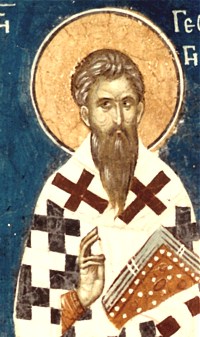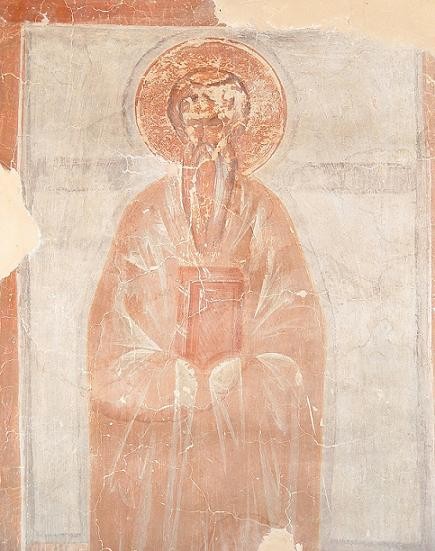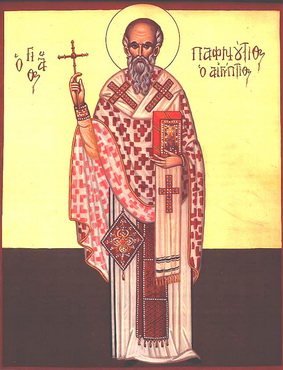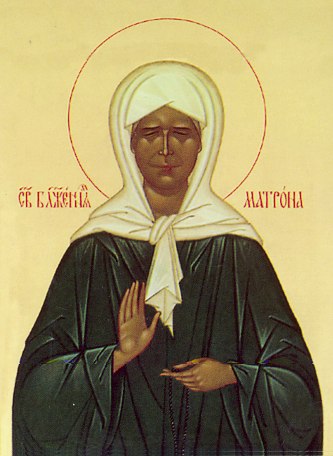|
|
The venerable John of the old caves John lived a life of asceticism in the so-called "old caves," the "old Lavra" of Chariton the Great in Palestine. Having loved Christ the Lord with all his heart, with all his soul and with all his mind, John, at an early age, began to travel to the holy places and to listen to the instructions and counsels of the holy men. Finally, he settled in the Caves of Chariton, where he gave himself to rigorous asceticism spending days and years in fasting, prayer, vigils, continuously meditating on death, and teaching himself humility. As a good ripened fruit, he was plucked by death and took up habitation in Paradise. He lived and died in the eighth century. John lived a life of asceticism in the so-called "old caves," the "old Lavra" of Chariton the Great in Palestine. Having loved Christ the Lord with all his heart, with all his soul and with all his mind, John, at an early age, began to travel to the holy places and to listen to the instructions and counsels of the holy men. Finally, he settled in the Caves of Chariton, where he gave himself to rigorous asceticism spending days and years in fasting, prayer, vigils, continuously meditating on death, and teaching himself humility. As a good ripened fruit, he was plucked by death and took up habitation in Paradise. He lived and died in the eighth century.The holy martyrs Christopher, Theonas and AntoniusChristopher, Theonas and Antonius were young officers serving under Emperor Diocletian. When St. George the Great Martyr was being tortured, they witnessed his sufferings as well as the miracles which occurred at that time. Seeing all of this, they came before the emperor, laid down their arms, removed their military belts and bravely confessed the Name of the Lord Jesus. For that, they were subjected to great torture and finally were tossed into the fire, where their bodies were consumed while their souls went to God into eternal joy. They honorably suffered in Nicomedia in the year 303 A.D.
Saint Tryphun, patriarch of Constantinople The Emperor Romanus, who reigned over Byzantium at the beginning of the tenth century had a son, Theophylact, who was sixteen years old when Patriarch Stephen died. The emperor wanted his son to be elevated as patriarch for he had promised him [his son] this spiritual calling from his youth. Because his son was a minor, the emperor was ashamed to do this. The patriarchal throne was assumed by Tryphun a simple but chaste and pious old man. Tryphun remained on the throne for three years. When the son of the emperor reached his twentieth year, the emperor thought, to remove Tryphun at any price and to install his son as patriarch. The saint of God, Tryphun, did not want to relinquish his throne voluntarily, for no other reason, because he considered it to be a great scandal that such a young man be elevated to such a responsible and burdensome position as that of being patriarch. Through the intrigue of a nefarious bishop, the signature of the innocent Tryphun was extracted on a blank sheet of paper. Later on, in the imperial court, above that signature, the alleged resignation of the patriarch was written which the emperor decreed. As a result of this, there arose a great confusion in the Church, for the laity and the clergy stood by Tryphun, the godly man. The emperor then forcibly removed the aged patriarch and sent him to a monastery and, his son, Theophylact, was elevated as patriarch. St. Tryphun lived as an ascetic in this monastery for two years and five months and presented himself before the Lord in the year 933 A.D. The Emperor Romanus, who reigned over Byzantium at the beginning of the tenth century had a son, Theophylact, who was sixteen years old when Patriarch Stephen died. The emperor wanted his son to be elevated as patriarch for he had promised him [his son] this spiritual calling from his youth. Because his son was a minor, the emperor was ashamed to do this. The patriarchal throne was assumed by Tryphun a simple but chaste and pious old man. Tryphun remained on the throne for three years. When the son of the emperor reached his twentieth year, the emperor thought, to remove Tryphun at any price and to install his son as patriarch. The saint of God, Tryphun, did not want to relinquish his throne voluntarily, for no other reason, because he considered it to be a great scandal that such a young man be elevated to such a responsible and burdensome position as that of being patriarch. Through the intrigue of a nefarious bishop, the signature of the innocent Tryphun was extracted on a blank sheet of paper. Later on, in the imperial court, above that signature, the alleged resignation of the patriarch was written which the emperor decreed. As a result of this, there arose a great confusion in the Church, for the laity and the clergy stood by Tryphun, the godly man. The emperor then forcibly removed the aged patriarch and sent him to a monastery and, his son, Theophylact, was elevated as patriarch. St. Tryphun lived as an ascetic in this monastery for two years and five months and presented himself before the Lord in the year 933 A.D.The venerable martyr Agathangelus Agathangelus was from Thrace. His secular name was Athanasius. Serving the Turks, he was forcibly converted to Islam in Smyrna. As a penitent, he was tonsured a monk on the Holy Mountain [Athos] in the Monastery of Esfigmenu. Tortured by his conscience, he desired to wash away his sin with his own blood. He departed for Smyrna where he exhibited a cross and an icon of the resurrection of Christ before the Turks. He was beheaded on April 19, 1819 in his nineteenth year. Following his death, he appeared alive to Herman, his spiritual father. Agathangelus was from Thrace. His secular name was Athanasius. Serving the Turks, he was forcibly converted to Islam in Smyrna. As a penitent, he was tonsured a monk on the Holy Mountain [Athos] in the Monastery of Esfigmenu. Tortured by his conscience, he desired to wash away his sin with his own blood. He departed for Smyrna where he exhibited a cross and an icon of the resurrection of Christ before the Turks. He was beheaded on April 19, 1819 in his nineteenth year. Following his death, he appeared alive to Herman, his spiritual father.Venerable Simeon the discalced (barefooted one) Simeon lived a life of asceticism on the Holy Mountain [Athos] and, for a short while, was the abbot of the Monastery Philotheu. He strengthened Christians in the Faith in many areas of the Balkans and was glorified by his miracle-working. He walked barefooted for which he is called, the Discalced (The Barefooted One). He died in Constantinople. Simeon lived a life of asceticism on the Holy Mountain [Athos] and, for a short while, was the abbot of the Monastery Philotheu. He strengthened Christians in the Faith in many areas of the Balkans and was glorified by his miracle-working. He walked barefooted for which he is called, the Discalced (The Barefooted One). He died in Constantinople.Saint George the Confessor, Bishop of Pisidian Antioch (813-820) Sainted George the Confessor, Bishop of Pisidian Antioch, lived during the Iconoclast period. In his youth he became a monk, was known for his holiness of life and was made bishop of Pisidian Antioch.
During the time of persecution against holy icons under the emperor Leo the Armenian (813-820), Saint George was at Constantinople and at a Council of bishops he denounced the Iconoclast heresy, calling on the emperor to forsake it. When Saint George refused to remove the icons from the church by decree of the emperor, he was exiled to imprisonment (+ c. 813-820). Sainted George the Confessor, Bishop of Pisidian Antioch, lived during the Iconoclast period. In his youth he became a monk, was known for his holiness of life and was made bishop of Pisidian Antioch.
During the time of persecution against holy icons under the emperor Leo the Armenian (813-820), Saint George was at Constantinople and at a Council of bishops he denounced the Iconoclast heresy, calling on the emperor to forsake it. When Saint George refused to remove the icons from the church by decree of the emperor, he was exiled to imprisonment (+ c. 813-820).Venerable Nicephorus, abbot of Katabad The Monk Nicephoros was born at Constantinople into a rich and illustrious family. His parents, Andrew and Theodora, raised their son in the Christian faith. After their death, young Nicephoros distributed all his wealth to the poor and set off to Chalcedon. The strict manner of monastic life at the monastery of Saint Andrew appealed to Nicephoros, and he remained amidst the brethren there... The Monk Nicephoros was born at Constantinople into a rich and illustrious family. His parents, Andrew and Theodora, raised their son in the Christian faith. After their death, young Nicephoros distributed all his wealth to the poor and set off to Chalcedon. The strict manner of monastic life at the monastery of Saint Andrew appealed to Nicephoros, and he remained amidst the brethren there...Hieromartyr Paphnutius of Jerusalem The PriestMartyr Paphnutios of Jerusalem was a bishop. He underwent many sufferings from the pagans and was tortured by fire, by beasts, and finally was beheaded by the sword.
Some suggest, that the PriestMartyr Paphnutios was an Egyptian bishop and suffered together with many other Egyptians, exiled to the Palestinian mines during the persecution by Diocletian (284-305).
The myrh-flowing relics of the priest-martyr were glorified by miracles. The kanon to him was compiled during the Iconoclast period (pre-842). In the final ode to him is done a petition about the aid of the priest-martyr in putting an end to the heresy disrupting the Church. The PriestMartyr Paphnutios of Jerusalem was a bishop. He underwent many sufferings from the pagans and was tortured by fire, by beasts, and finally was beheaded by the sword.
Some suggest, that the PriestMartyr Paphnutios was an Egyptian bishop and suffered together with many other Egyptians, exiled to the Palestinian mines during the persecution by Diocletian (284-305).
The myrh-flowing relics of the priest-martyr were glorified by miracles. The kanon to him was compiled during the Iconoclast period (pre-842). In the final ode to him is done a petition about the aid of the priest-martyr in putting an end to the heresy disrupting the Church.St. Matrona the Blind of Moscow (1952) Matrona was born in 1881 into a poor family in the village of Sebino-Epifaniskaya (now Kimovski) in the Tula region of Russia. Blind from birth, she bore her infirmity with humility and patience, and God made her a vessel of grace. At the moment of her baptism, the priest saw a cloud above the child, which shed forth a sweet fragrance as a sign of divine favor. From the age of six or seven, she exhibited an extraordinary gift of insight, discerning sicknesses of soul and body in the many people who visited her, revealing to them their secret sins and their problems, and healing them through prayer and wise counsel... Matrona was born in 1881 into a poor family in the village of Sebino-Epifaniskaya (now Kimovski) in the Tula region of Russia. Blind from birth, she bore her infirmity with humility and patience, and God made her a vessel of grace. At the moment of her baptism, the priest saw a cloud above the child, which shed forth a sweet fragrance as a sign of divine favor. From the age of six or seven, she exhibited an extraordinary gift of insight, discerning sicknesses of soul and body in the many people who visited her, revealing to them their secret sins and their problems, and healing them through prayer and wise counsel... |